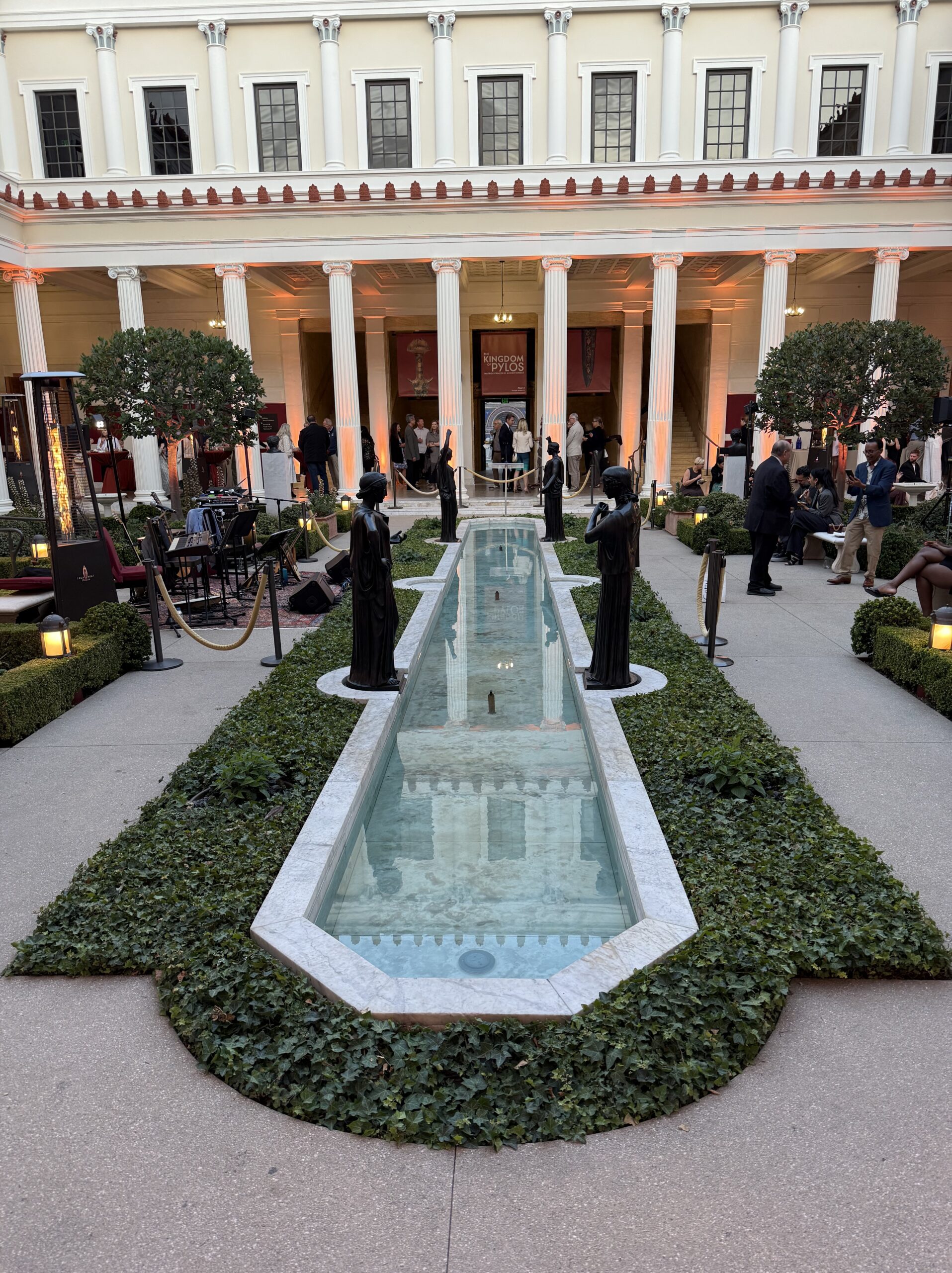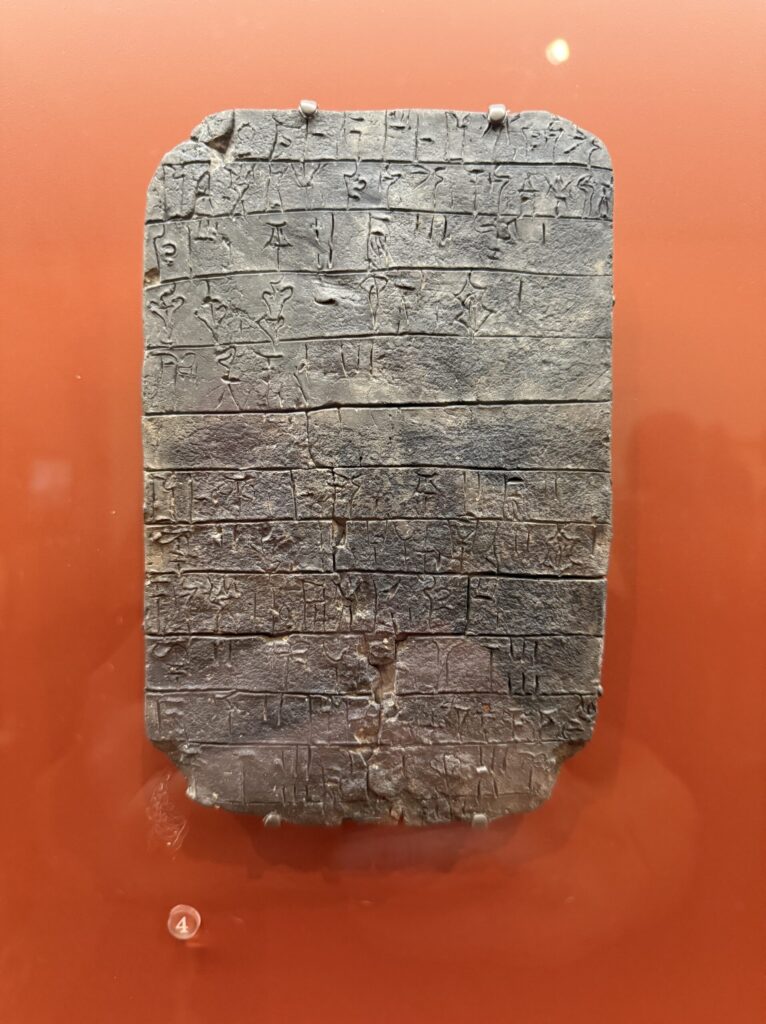By Regina Luz Jordan, Editor in Chief, Hollywoodland News
Six months ago, fire came down the hillside above the Getty Villa. It swept through Pacific Palisades with Santa Ana fury, scorching trees, blackening slopes and shutting down one of LA’s most breathtaking cultural landmarks. Sometimes you don’t know how much you miss the beautiful places in this sprawling metropolis until you don’t have access to them anymore. The Getty Villa reopens and it’s a reckoning.
Hollywoodland News had the opportunity to visit the Getty Villa on its inaugural grand reopening for the launch of its new exhibit, The Kingdom of The Kingdom of Pylos: Warrior-Princes of Mycenaean Greece and to walk the grounds.
What I found wasn’t just ancient art and ocean views. It was a site actively living its own chapter of history, one marked by loss, survival and the audacity to keep going.

The Villa, Scarred and Stunning
From the moment you turn off Highway 1, you feel it. What used to be a shaded, lush approach has been stripped bare. Hills that once hid the Villa in layers of sycamores and coastal brush are now exposed, silent and raw. The drive up doesn’t feel scenic, the way it used to. It feels like trespassing. Like you’re moving through someone else’s grief and you’re not sure which way to go.
We were very mindful of this, as evidenced by our lack of photos because while we understand that we are a media brand, we also understand that it’s in active bruise, healing and recovery mode.

Once you arrive, the contrast becomes even sharper. The Villa itself is intact. The architecture is as pristine as ever. The marble still glows in the sunlight. But everything around it carries weight. There’s charred tree trunks. There are empty slopes and a sky that somehow feels wider because there’s nothing left to frame it.
It’s not a ruin, but it’s not a full recovery either. It’s something in between.
Inside the grounds, the gardens are groomed, the fountains restored and the art preserved. But the surroundings refuse to let you forget what happened and honestly, they shouldn’t. It’s a visible reckoning between past and present. The Villa isn’t just welcoming visitors back. It’s asking them to notice what’s missing.
The Billionaire Who Built It (But Wouldn’t Pay a Ransom Without a Tax Write-Off)
Here’s the thing about the Getty Villa, it didn’t just spring up from cultural goodwill. It came from the warped, oil-slicked mind of J. Paul Getty, the billionaire who built an empire on extraction and arrogance. He was a collector, sure, but only when the price was right. And by “right,” I mean cheap.

Getty was so stingy that it limited the quality of his own art collection. Imagine being one of the richest men on Earth and still bargaining like you’re at a yard sale. And yet, at the time of his death, Getty still managed to hoard over 600 pieces of fine art, works by Rubens, Titian, Renoir, Monet, Degas, all collected under a philosophy of maximum control and minimum generosity.
His pettiness wasn’t limited to the art world. After donating a few pieces to the Los Angeles Museum of History, Science and Art and seeing them poorly displayed, Getty basically ghosted the city of LA. He refused to give the county anything else. That snub forced a whole separate fundraising effort just to get LACMA built without him.
When he finally got tired of hoarding Greek and Roman sculptures in his Surrey mansion, he had the Villa built to house them. Not in Europe. Not in partnership with a public institution. But on prime California land, so he could control every detail from the landscaping to the lighting. The man built a temple to his own ego and filled it with plunder.
And just in case you’re still wondering what kind of man he was because you weren’t convinced from the last few paragraphs, let’s talk about the ear. In 1973, his 16-year-old grandson was kidnapped in Rome.
They asked for $17 million in return for J. Paul Getty III.
Getty said no because he didn’t want to “encourage” other people to kidnap his other grandchildren.

Then they cut off the boy’s ear and mailed it to a newspaper.
Getty finally agreed to pay the ransom, but only the part that was tax-deductible. He covered $2.2 million. He loaned the rest of the money to his own son, with a 4% interest rate. When the kid was released, earless and traumatized, he called to say thank you to Grandpa Getty and it’s alleged that he refused to take the call.

This is the legacy that funds the Villa. This is the man who tried to buy immortality but couldn’t be bothered to pick up the phone when his family needed him which is hilarious considering he had a pay phone installed in one of his homes for his guests.
So yeah, the Getty Villa reopens and you can walk the gardens and admire the mosaics. But don’t forget who paid for the marble or how many people paid the price for his version of greatness.
A New Exhibit Rooted in Resilience
If you’re going to reopen a museum after a wildfire turns your hillside into a graveyard of tree stumps, you better bring something powerful to the table. The Getty Villa delivered. The Kingdom of Pylos: Warrior-Princes of Ancient Greece is a flex.
Over 230 artifacts, many of them never before seen in the U.S., are now on display.
Pictured to my right: a Mycenaean clay tablet from around 1180 BCE documenting a festival for Poseidon, featuring bulls, sheep, honey and 173 liters of wine, because apparently the ancient Greeks invented the open bar

We’re talking gold rings, ceremonial swords, seal stones, pottery and burial treasures that tell the story of a Bronze Age civilization known for opulence, strategy and mythic masculinity. If Homer had a merch table, this is what would be on it.
Pictured to my left: a conical rhyton with palm trees, used by Mycenaeans around 1520 BCE to pour wine, oil or water during ritual meals because even in the Bronze Age, presentation mattered.
I didn’t go alone. I invited my friend, Dr. Timothy Doran, Full Professor in Cal State LA’s History Department and faculty advisor for the Classical, Ancient and Medieval Global Studies program. Because here’s the truth: the only thing I really understand about Ancient Greece is that Zeus was a womanizing thunder daddy who was definitely not real. I needed someone who could help me make sense of what I was looking at.
Dr. Doran’s presence elevated the whole experience. He pointed out details I would have missed, the symbolism, the craftsmanship and the funerary context behind some of the pieces.
Pictured to my left: the handles of a bronze cauldron buried with the dead near the Palace of Nestor. Note the handles shaped like human hands, because apparently creepy cookware was all the rage in 1600 BCE.
Having Dr. Doran as a guest, turned a powerful exhibit into a fully immersive lesson on survival, power and legacy. It was the kind of museum trip where you leave smarter, not just impressed.

And what really lands is the timing. You walk through objects that have survived thousands of years, conquest, ruin, excavation, the black market and here they are, displayed in a building that just survived its own brush with destruction.
There’s something poetic about it, whether Getty intended it or not. A culture built on ceremony and conquest, rising again in a museum that just had to reckon with nature’s version of conquest: fire, loss, cleanup, rebirth. It feels like proof that legacy can outlive chaos. That objects can carry memory long after the smoke clears.
Fire as a Chapter, Not a Footnote when the Getty Villa Reopens

The Getty’s leadership didn’t try to cover up what happened and honestly, respect for that. President and CEO, Katherine E. Fleming made it clear: the decision to leave the damage visible was a choice.
“This fire is part of the history of this place,” she said. And in a city obsessed with reinvention, that kind of transparency feels rare. Most institutions would’ve steamrolled the blackened hills, planted some fast growing ficus, and pretended nothing happened.
The Villa lets you see all of this and it captures the feeling of loss in its stillness. It displays history while admitting to living through it.
Even LA’s Mayor, Karen Bass, spoke to that moment of reckoning.
At the reopening ceremony, she called the Villa’s comeback a symbol of the city’s ongoing recovery.
“When we talk about the fastest recovery in state’s history, this is what we are talking about,” she said. “We have a long road ahead. And we must hold on to those moments of hope and know that you will continue working around the clock to get you home. Everyone who lost their homes.”

The Villa is different now, and for the better. Sure, this museum is polished marble and mythic mosaics but it’s also a space that sits with its damage. It’s still beautiful, but it’s no longer pretending to be untouchable. The fire left its mark, and instead of scrubbing it away, the Villa carved it into the story, which is already more emotional maturity than J. Paul Getty ever managed in a lifetime of hoarding artifacts and avoiding phone calls from his kidnapped grandson.
It begs asking the question, if Getty could see the Villa now, scarred and self-aware, would he try to lowball it on fire insurance and call it a tax write-off?
A Place to Breathe Again

In a city that bulldozes its own past and slaps new branding on the rubble, this kind of restoration matters.
The Getty Villa didn’t erase the damage. It absorbed it. It let the scars show and that gives the place more soul than any imported column or god-tier sculpture ever could.
So if you’re looking for a museum experience that’s more than just perfectly lit selfies and marble grandeur, go. Make the drive. See what’s changed. Sit with what remains. Let yourself feel it.
The Getty Villa isn’t just back. It’s bolder, quieter, and more human than it’s ever been. Somehow, in the middle of all the ashes, it remembered how to tell the truth.
Before Your Visit
- The Getty Villa is open Friday through Monday, 10 a.m. to 5 p.m.
- Timed-entry reservations are required.
- While the museum is free, parking is $25 per car or motorcycle; $15 after 3pm. For evening events, parking is $10 after 6pm.
- The Villa’s next outdoor theater production, Oedipus the King, Mama!, launches in September.
You can make reservations here or read More on the Getty Villa.



Leave a Reply